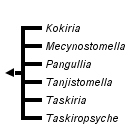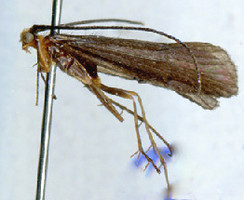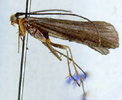Kokiriidae
Ralph W. Holzenthal, Roger J. Blahnik, Aysha Prather, and Karl Kjer


This tree diagram shows the relationships between several groups of organisms.
The root of the current tree connects the organisms featured in this tree to their containing group and the rest of the Tree of Life. The basal branching point in the tree represents the ancestor of the other groups in the tree. This ancestor diversified over time into several descendent subgroups, which are represented as internal nodes and terminal taxa to the right.

You can click on the root to travel down the Tree of Life all the way to the root of all Life, and you can click on the names of descendent subgroups to travel up the Tree of Life all the way to individual species.
For more information on ToL tree formatting, please see Interpreting the Tree or Classification. To learn more about phylogenetic trees, please visit our Phylogenetic Biology pages.
close boxIntroduction
McFarlane (1964) erected the plectrotarsid subfamily Kokiriinae when he described Kokiria miharo from New Zealand. Subsequently, Ross (1967) raised it to family status and included the Chilean species Rhynchopsyche fusca Schmid (originally described in Brachycentridae) in the new family. Neboiss (1974) described Tanjistomella verna, the first record of the family in Australia; in that work he also referred the New Caledonian genus Mecynostomella Kimmins (originally placed in Sericostomatidae) to Kokiriidae. Neboiss later described 2 more Australasian genera, Taskiria and Taskiropsyche. Flint et al. (1999) considered Rhynchopsyche fusca a junior synonym of Pangullia faziana Navás (originally described in Limnephilidae). Johanson (2003) recently revised Mecynostomella and nearly doubled the described species diversity of Kokiriidae, so that it now consists of 15 species described from New Zealand, New Caledonia, Chile, and Australia. The larvae are predatory, and live in sandy deposits of small streams and lakes. Larval cases are constructed from sand, and are dorsoventrally depressed and flanged around the edge. (From Holzenthal et al., 2007a)Discussion of Phylogenetic Relationships
This family has been considered by various authors to be closely allied with either limnephiloid or leptoceroid families, in the latter case possibly because of the similarity of the larval cases to those of molannids and some Ceraclea (Leptoceridae). However, the characters proposed by Frania and Wiggins (1997) to support a close relationship with Molannidae have not held up to re-examination (Prather 2002), nor are they corroborated in recent molecular studies (Holzenthal et al. 2007b, Kjer et al. 2001, 2002). (From Holzenthal et al., 2007a)References
Holzenthal R.W., Blahnik, R.J., Prather, A.L., and Kjer K.M. 2007a. Order Trichoptera Kirby 1813 (Insecta), Caddisflies. In: Zhang, Z.-Q., and Shear, W.A. (Eds). 2007 Linneaus Tercentenary: Progress in Invertebrate Taxonomy. Zootaxa. 1668:639–698.
Holzenthal R.W., Blahnik, R.J., Kjer K.M and Prather, A.L. 2007b. An update on the phylogeny of Caddisflies (Trichoptera). Proceedings of the XIIth International Symposium on Trichoptera. Bueno-Soria, R. Barba-Alvearz and B. Armitage (Eds). Pp. 143-153. The Caddis Press.
Flint, O.S., Jr. (1967) Trichoptera collected by Prof. J. Illies in the Chilean subregion. Beiträge zur Neotropischen Fauna, 5, 45–68.
Johanson, K.A. (2003b) Revision of New Caledonian genus Mecynostomella (Trichoptera, Kokiriidae). Zootaxa, 270, 1–24.
Kjer, K.M., Blahnik, R.J. & Holzenthal, R.W. (2001) Phylogeny of Trichoptera (caddisflies): characterization of signal and noise within multiple datasets. Systematic Biology, 50, 781–816.
Kjer, K.M., Blahnik, R.J. & Holzenthal, R.W. (2002) Phylogeny of caddisflies (Insecta, Trichoptera). Zoologica Scripta, 31, 83–91.
McFarlane (1964)
Neboiss, A. (1974) Additions to the family Kokiriidae (Trichoptera). Victorian Naturalist, 91, 175–179.
Prather, A.L. (2002) Phylogenetic analysis of Leptoceroidea and Calamoceratidae, and revisions of the Neotropical genera Banyallarga and Phylloicus (Insecta: Trichoptera). Ph.D. Dissertation, University of Minnesota, St. Paul, Minnesota, USA, 486 pp.
Ross, H.H. (1967) The evolution and past dispersal of the Trichoptera. Annual Review of Entomology, 12, 169–206.
Title Illustrations

| Scientific Name | Pangulia faziana |
|---|---|
| Location | Tregualamu Chile |
| Specimen Condition | Dead Specimen |
| Identified By | O. Flint Jr. |
| Life Cycle Stage | Adult |
| View | Lateral |
| Collection | NMNH |
| Collector | C & O Flint |
| Source Collection | Barcode of Life Database (BOLD) |
About This Page
Ralph W. Holzenthal

University of Minnesota, St. Paul, Minnesota, USA
Roger J. Blahnik

University of Minnesota, St. Paul, Minnesota, USA
Aysha Prather

Centre for Biodiversity and Conservation Biology, Royal Ontario Museum, Toronto, Ontario, Canada
Karl Kjer

Rutgers University, New Brunswick, New Jersey, USA
Correspondence regarding this page should be directed to Ralph W. Holzenthal at , Roger J. Blahnik at , Aysha Prather at , and Karl Kjer at
Page copyright © 2010 Ralph W. Holzenthal, Roger J. Blahnik, Aysha Prather, and Karl Kjer
 Page: Tree of Life
Kokiriidae.
Authored by
Ralph W. Holzenthal, Roger J. Blahnik, Aysha Prather, and Karl Kjer.
The TEXT of this page is licensed under the
Creative Commons Attribution-NonCommercial-ShareAlike License - Version 3.0. Note that images and other media
featured on this page are each governed by their own license, and they may or may not be available
for reuse. Click on an image or a media link to access the media data window, which provides the
relevant licensing information. For the general terms and conditions of ToL material reuse and
redistribution, please see the Tree of Life Copyright
Policies.
Page: Tree of Life
Kokiriidae.
Authored by
Ralph W. Holzenthal, Roger J. Blahnik, Aysha Prather, and Karl Kjer.
The TEXT of this page is licensed under the
Creative Commons Attribution-NonCommercial-ShareAlike License - Version 3.0. Note that images and other media
featured on this page are each governed by their own license, and they may or may not be available
for reuse. Click on an image or a media link to access the media data window, which provides the
relevant licensing information. For the general terms and conditions of ToL material reuse and
redistribution, please see the Tree of Life Copyright
Policies.
- First online 17 July 2010
- Content changed 20 July 2010
Citing this page:
Holzenthal, Ralph W., Roger J. Blahnik, Aysha Prather, and Karl Kjer. 2010. Kokiriidae. Version 20 July 2010 (under construction). http://tolweb.org/Kokiriidae/141326/2010.07.20 in The Tree of Life Web Project, http://tolweb.org/







 Go to quick links
Go to quick search
Go to navigation for this section of the ToL site
Go to detailed links for the ToL site
Go to quick links
Go to quick search
Go to navigation for this section of the ToL site
Go to detailed links for the ToL site